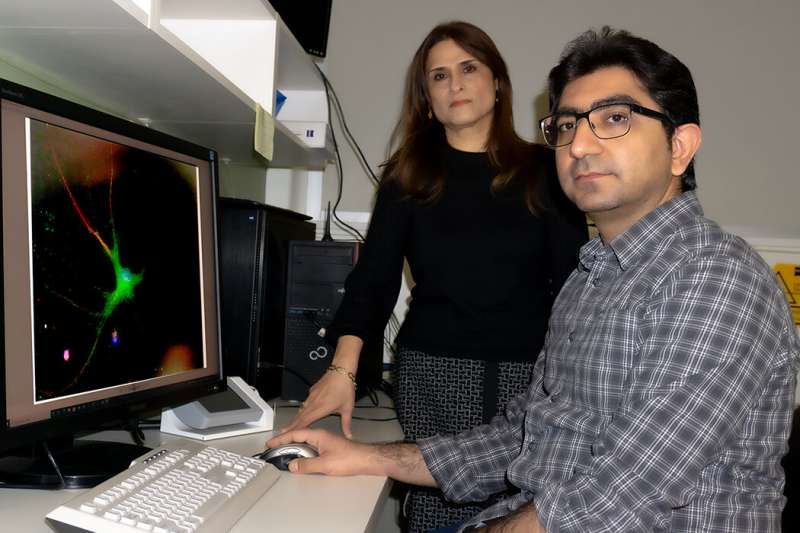Dr. Seyed Mojtaba Hosseini (right) and Dr. Soheila Karimi have published a paper in the Journal of Neuroscience about a new stem cell therapy for treating spinal cord injuries. Credit: University of Manitoba
A new study by University of Manitoba researchers has developed a stem cell-based therapy that may eventually lead to new regenerative treatments for people with spinal cord injuries.
Dr. Soheila Karimi, professor of physiology and pathophysiology at the Max Rady College of Medicine, Rady Faculty of Health Sciences, and her colleagues have developed a treatment strategy that can remarkably optimize the outcomes of neural stem cell transplantation and restore function of rats with spinal cord injury.
"We are excited about these new findings as they hold promise to facilitate the translation of neural stem cell therapies for treating a debilitating neurological condition that affects millions of people worldwide," said Karimi, who is also a scientist at the Children's Hospital Research Institute of Manitoba.
Neural stem cell transplantation offers tremendous potential for tissue repair after spinal cord injury, however low survival of transplanted stem cells and their inefficiency to replace damaged spinal cord cells have challenged its success in clinical applications, said Karimi, the senior author of this study.
"We have discovered that presence of a class of inhibitory molecules in the injured spinal cord potently limits success of stem cell transplantation," Karimi said. "When we blocked these molecules therapeutically at the time of transplantation, the treatment led to an increase in stem cell survival and generated suitable neural cells in the injured spine—major challenges with existing stem cell therapy approaches. This strategy enabled rats to walk with more weight support and coordination."
The work, led by the first author, Dr. Seyed Mojtaba Hosseini, a doctoral student on Dr. Karimi's research team, is titled "Suppressing CSPG/LAR/PTPs Axis Facilitates Neuronal Replacement and Synaptogenesis by Human Neural Precursor Grafts and Improves Recovery after Spinal Cord Injury" and is published in the Journal of Neuroscience.
"This research breaks new ground by developing a targeted approach, which can direct transplanted neural stem cells to generate the types of cells that are critical for repairing the damaged spinal cord," Karimi said. "Importantly, this treatment supported the long-term survival and functional integration of these newly formed cells within the host injured spinal cord that are key to successful tissue repair after a spinal cord injury."
Spinal cord injury is a devastating, costly neurological condition, Karimi said. Currently, more than 86,000 Canadians live with spinal cord injury whom 40 percent are under the age of 45, with nearly 1,400 new cases each year, she said. According to the Rick Hansen Spinal Cord Injury Registry, in 2019, the annual cost of spinal cord injury in Canada is estimated at $2.7 billion. These costs include medical management and hospitalization, as well as indirect costs such as lost/reduced productivity, she said.
"Individuals with spinal cord injury live with the debilitating consequences of the disease for decades, and development of new regenerative medicine treatments is an unmet need to improve the quality of life for a large population of people," Karimi said.
More information: Seyed Mojtaba Hosseini et al, Suppressing CSPG/LAR/PTPσ Axis Facilitates Neuronal Replacement and Synaptogenesis by Human Neural Precursor Grafts and Improves Recovery after Spinal Cord Injury, The Journal of Neuroscience (2022). DOI: 10.1523/JNEUROSCI.2177-21.2022
Journal information: Journal of Neuroscience
Provided by University of Manitoba























